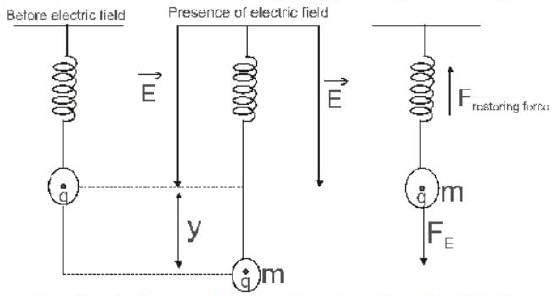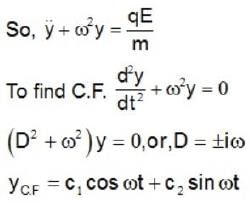GATE Exam > GATE Questions > A point particle of mass m carrying an electr...
Start Learning for Free
A point particle of mass m carrying an electric charge q is attached to a spring of stiffness constant k. A constant electric field E along the direction of the spring is switched on for a time interval T(whereT  Neglecting radiation loss, the amplitude of oscillation after the field is switched off is
Neglecting radiation loss, the amplitude of oscillation after the field is switched off is
 Neglecting radiation loss, the amplitude of oscillation after the field is switched off is
Neglecting radiation loss, the amplitude of oscillation after the field is switched off is- a)

- b)

- c)

- d)

Correct answer is option 'D'. Can you explain this answer?
| FREE This question is part of | Download PDF Attempt this Test |
Verified Answer
A point particle of mass m carrying an electric charge q is attached t...
Let, in presence of electric field, the spring elongates by; distance ‘y’

The direction of motion is along y direction, then equation of motion is,



Now,

 Now, apply boundary conditions, at t = 0, y = 0
Now, apply boundary conditions, at t = 0, y = 0

where,
Now, the amplitude of oscillation is,

The direction of motion is along y direction, then equation of motion is,



Now,

 Now, apply boundary conditions, at t = 0, y = 0
Now, apply boundary conditions, at t = 0, y = 0
where,

Now, the amplitude of oscillation is,


|
Explore Courses for GATE exam
|

|
Similar GATE Doubts
A point particle of mass m carrying an electric charge q is attached to a spring of stiffness constant k. A constant electric field E along the direction of the spring is switched on for a time interval T(whereT Neglecting radiation loss, the amplitude of oscillation after the field is switched off isa)b)c)d)Correct answer is option 'D'. Can you explain this answer?
Question Description
A point particle of mass m carrying an electric charge q is attached to a spring of stiffness constant k. A constant electric field E along the direction of the spring is switched on for a time interval T(whereT Neglecting radiation loss, the amplitude of oscillation after the field is switched off isa)b)c)d)Correct answer is option 'D'. Can you explain this answer? for GATE 2024 is part of GATE preparation. The Question and answers have been prepared according to the GATE exam syllabus. Information about A point particle of mass m carrying an electric charge q is attached to a spring of stiffness constant k. A constant electric field E along the direction of the spring is switched on for a time interval T(whereT Neglecting radiation loss, the amplitude of oscillation after the field is switched off isa)b)c)d)Correct answer is option 'D'. Can you explain this answer? covers all topics & solutions for GATE 2024 Exam. Find important definitions, questions, meanings, examples, exercises and tests below for A point particle of mass m carrying an electric charge q is attached to a spring of stiffness constant k. A constant electric field E along the direction of the spring is switched on for a time interval T(whereT Neglecting radiation loss, the amplitude of oscillation after the field is switched off isa)b)c)d)Correct answer is option 'D'. Can you explain this answer?.
A point particle of mass m carrying an electric charge q is attached to a spring of stiffness constant k. A constant electric field E along the direction of the spring is switched on for a time interval T(whereT Neglecting radiation loss, the amplitude of oscillation after the field is switched off isa)b)c)d)Correct answer is option 'D'. Can you explain this answer? for GATE 2024 is part of GATE preparation. The Question and answers have been prepared according to the GATE exam syllabus. Information about A point particle of mass m carrying an electric charge q is attached to a spring of stiffness constant k. A constant electric field E along the direction of the spring is switched on for a time interval T(whereT Neglecting radiation loss, the amplitude of oscillation after the field is switched off isa)b)c)d)Correct answer is option 'D'. Can you explain this answer? covers all topics & solutions for GATE 2024 Exam. Find important definitions, questions, meanings, examples, exercises and tests below for A point particle of mass m carrying an electric charge q is attached to a spring of stiffness constant k. A constant electric field E along the direction of the spring is switched on for a time interval T(whereT Neglecting radiation loss, the amplitude of oscillation after the field is switched off isa)b)c)d)Correct answer is option 'D'. Can you explain this answer?.
Solutions for A point particle of mass m carrying an electric charge q is attached to a spring of stiffness constant k. A constant electric field E along the direction of the spring is switched on for a time interval T(whereT Neglecting radiation loss, the amplitude of oscillation after the field is switched off isa)b)c)d)Correct answer is option 'D'. Can you explain this answer? in English & in Hindi are available as part of our courses for GATE.
Download more important topics, notes, lectures and mock test series for GATE Exam by signing up for free.
Here you can find the meaning of A point particle of mass m carrying an electric charge q is attached to a spring of stiffness constant k. A constant electric field E along the direction of the spring is switched on for a time interval T(whereT Neglecting radiation loss, the amplitude of oscillation after the field is switched off isa)b)c)d)Correct answer is option 'D'. Can you explain this answer? defined & explained in the simplest way possible. Besides giving the explanation of
A point particle of mass m carrying an electric charge q is attached to a spring of stiffness constant k. A constant electric field E along the direction of the spring is switched on for a time interval T(whereT Neglecting radiation loss, the amplitude of oscillation after the field is switched off isa)b)c)d)Correct answer is option 'D'. Can you explain this answer?, a detailed solution for A point particle of mass m carrying an electric charge q is attached to a spring of stiffness constant k. A constant electric field E along the direction of the spring is switched on for a time interval T(whereT Neglecting radiation loss, the amplitude of oscillation after the field is switched off isa)b)c)d)Correct answer is option 'D'. Can you explain this answer? has been provided alongside types of A point particle of mass m carrying an electric charge q is attached to a spring of stiffness constant k. A constant electric field E along the direction of the spring is switched on for a time interval T(whereT Neglecting radiation loss, the amplitude of oscillation after the field is switched off isa)b)c)d)Correct answer is option 'D'. Can you explain this answer? theory, EduRev gives you an
ample number of questions to practice A point particle of mass m carrying an electric charge q is attached to a spring of stiffness constant k. A constant electric field E along the direction of the spring is switched on for a time interval T(whereT Neglecting radiation loss, the amplitude of oscillation after the field is switched off isa)b)c)d)Correct answer is option 'D'. Can you explain this answer? tests, examples and also practice GATE tests.

|
Explore Courses for GATE exam
|

|
Suggested Free Tests
Signup for Free!
Signup to see your scores go up within 7 days! Learn & Practice with 1000+ FREE Notes, Videos & Tests.


















